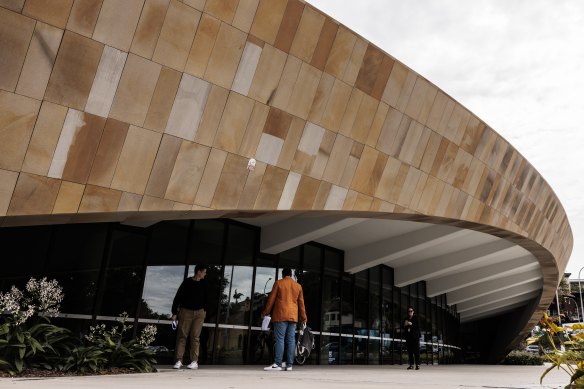By Lucy Carroll
One of Sydney’s wealthiest private schools has unveiled its $125 million building revamp – including an aquatic centre, a theatre and a basement car park – amid a construction boom in the independent school sector.
Cranbrook’s new sandstone encased five-storey building, which includes 25 classrooms, a double-height orchestra room, a 267-seat theatre, a chapel, an indoor Olympic-sized pool and a gymnasium, is set to be opened by NSW Governor Margaret Beazley on Saturday.

Cranbrook’s new building includes 25 new classrooms, an aquatic centre and a double-height orchestra room.Credit: Brook Mitchell
School council president Jon North said parents and old boys at the century-old Anglican school, which plans to admit girls from 2026, donated at least $25 million for the upgrade.
More than a dozen private schools including Meriden School, Newcastle Grammar and Trinity Grammar are planning multimillion-dollar building projects as institutions overhaul older buildings or expand as they increase enrolment caps and bolster student numbers.
Association of Independent Schools of NSW chief executive Geoff Newcombe estimates the state’s private schools have spent $1.5 billion on new building projects in the past five years.
Most high-fee private school funding comes from parent fees. Federal and state governments contribute between $3000 to $10,000 for each student, or a minimum of about $5 million a year, to independent schools depending on student numbers. Public funding for private schools must be spent on the costs of running the schools, rather than capital works.
Al-Faisal College in Liverpool has under consideration by planning authorities a $281 million, 20-year plan that would include a new campus and a major boost to students numbers; upper north shore school Barker College has a $160 million infrastructure project in the pipeline; and inner-west school Trinity Grammar is planning a $115 million upgrade, including a new performing arts centre.
Cranbrook’s new Vicars Centenary Building (fund manager and former student Will Vicars donated at least $5 million) includes a 1600-seat assembly hall, a theatre, a gymnasium, a multipurpose court, “dining commons” with cafe, a timber chapel and “purpose-built learning centres”.
Headmaster Nicholas Sampson said the architecture was linked to the school’s educational philosophy: “The spaces [are] designed to encourage collaboration and flexible learning to support the school’s International Baccalaureate’s continuum approach and to help ready students for university and life beyond the school gates.”
University of Sydney education professor Helen Proctor said high-fee private schools “appear to be competing to outdo each other with new buildings and facilities”.
“Bells-and-whistles projects galvanise the school communities and attract tax-deductible donations, and extravagant upgrades mean the schools become expensive to run,” Proctor said. “They are also supported by very generous public funding.”
NSW Teachers Federation president Angelo Gavrielatos said while private schools invested in “obscene building projects”, public school students were in “demountables and in overcrowded schools that are in desperate need of refurbishment”.
The NSW government is investing $8.6 billion in public school infrastructure over the next four years on 160 new and upgraded schools. More than $9.1 billion has been invested in public school projects since 2017.
Paul Kidson, an education leadership academic at the Australian Catholic University, said the building projects at high-fee schools might encourage competition and the community needed “an honest discussion about these building pursuits in the context of the wider notion of the common good”.
But Newcombe said the amount of work independent schools were providing for the economy and the building industry was significant.
An Association of Independent Schools of NSW survey indicates private school enrolments are expected to rise by 2 to 3 per cent next year. Newcombe said capital funding provided to private schools was available to institutions in lower socio-economic areas with annual fees less than $12,000.
Cranbrook, which charges fees upwards of $40,000 for year 12, is the alma mater of billionaire Kerry Packer and his son James, and Atlassian founder Mike Cannon-Brookes. The school will become fully co-educational from years 7 to 12 within less than a decade. About 40 per cent of new student inquiries are from families with girls looking to enrol from 2026 onwards.
North said the response from students about the new building was positive. “They find it really inspirational,” he said.
“The school’s environment is important for learning and designed in line with Cranbrook’s educational philosophy, which is about inquiry and experience, and being creative.
“A lot of the facilities were built 50 years ago, and they were built for a smaller school and fundamentally we needed more teaching and learning spaces. We had a 25-metre pool that wasn’t very good for water polo. So we decided to build a proper pool and learn-to-swim school.”
A Cranbrook spokesperson said the facilities would be open to the “broader community through various activities including services held in the memorial chapel, musicals which are open to other schools, orchestral and musical ensembles and a learn-to-swim school and swim squads”.
The Morning Edition newsletter is our guide to the day’s most important and interesting stories, analysis and insights. Sign up here.